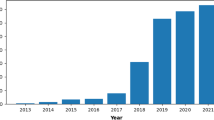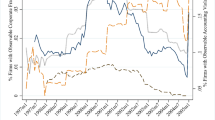“The market that looks most like a bubble to me is Bitcoin and its brethren.”
—Richard Thaler.
Abstract
There has been a burgeoning Fintech literature in the past years, especially on cryptocurrencies. However, there is lack of research handling cryptocurrencies in a mainstream macroeconomic model. To bridge the gap, we develop a model for Bitcoin-like cryptocurrency as risky and costly bubbles in an infinite-horizon production economy. This model is consistent with the following facts: (1) the surging Bitcoin market presents enormous volatility, (2) its price dynamics are significantly sensitive to both market sentiment and policy stances. Entrepreneurial firms choose to hold Bitcoins as liquid assets to buffer idiosyncratic investment distortions. The intrinsically worthless Bitcoins can emerge as rational bubbles when the market sentiment is optimistic enough. On the one hand, bubbly Bitcoins provide market liquidity to facilitate investment in the real sector, while on the other hand, they deteriorate the investment efficiency and crowd out aggregate production. Our quantitative exercise produces various cyclical features of Bitcoin bubbles and find that the collapse of Bitcoin bubbles can improve social welfare by decreasing distortion-driven real investment.
Similar content being viewed by others
References
Abadi, J., Brunnermeier, M.: Blockchain economics. mimeo, Princeton University (2018)
Aoki, K., Nikolov, K.: Bubbles, banks and financial stability. J. Monet. Econ. 74, 33–51 (2015)
Barsky, R.B., Sims, E.R.: News shocks and business cycles. J. Monet. Econ. 58(3), 273–289 (2011)
Bengui, J., Phan, T.: Asset pledgeability and endogenously leveraged bubbles. J. Econ. Theory 177, 280 (2018)
Bewley, T.: A difficulty with the optimum quantity of money. Econom. J. Econom. Soc. 51, 1485–1504 (1983)
Biais, B., Bisiere, C., Bouvard, M., Casamatta, C.: The blockchain folk theorem. Working paper (2018)
Bianchi, D.: Cryptocurrencies as an asset class: an empirical assessment. Working paper (2017)
Borri, N.: Conditional tail-risk in cryptocurrency markets. Working paper (2018)
Borri, N., Shakhnov, K.: Cryptomarket discounts. Working paper (2018)
Catalini, C., Gans, J.S.: Some simple economics of the blockchain. National Bureau of Economic Research, working paper (2016)
Chang, C., Chen, K., Waggoner, D.F., Zha, T.: Trends and cycles in China’s macroeconomy. NBER Macroecon. Annu. 30(1), 1–84 (2016)
Chen, K., Wen, Y.: The great housing boom of China. Am. Econ. J. Macroecon. 9(2), 73–114 (2017)
Chiu, J., Koeppl, T.V: The economics of cryptocurrencies: bitcoin and beyond (2017)
Cong, L.W., He, Z.: Blockchain disruption and smart contracts. National Bureau of Economic Research, working paper (2018)
Cong, L.W., Li, Y., Wang, N.: Tokenomics: dynamic adoption and valuation. Working paper (2018a)
Cong, L.W., He, Z., Li, J.: Decentralized mining in centralized pools. Working paper (2018b)
Davidson, S., De Filippi, P., Potts, J.: Economics of blockchain. Working paper (2016)
Dimitri, N.: Bitcoin mining as a contest. Ledger 2, 31–37 (2017)
Dong, F., Miao, J., Wang, P.: The perils of credit booms. Econ. Theory 66(4), 819–861 (2018)
Farhi, E., Tirole, J.: Bubbly liquidity. Rev. Econ. Stud. 79(2), 678–706 (2011)
Foley, S., Karlsen, J., Putniņš, T.J.: Sex, drugs, and bitcoin: how much illegal activity is financed through cryptocurrencies?. Working paper (2018)
Goolsbee, A.: Investment tax incentives, prices, and the supply of capital goods. Q. J. Econ. 113(1), 121–148 (1998)
Hilary, G., Liu, L.X.: Blockchain and finance. In preparation (2018)
Hirano, T., Yanagawa, N.: Asset bubbles, endogenous growth, and financial frictions. Rev. Econ. Stud. 84(1), 406–443 (2016)
Hu, A., Parlour, C.A., Rajan, U.: Cryptocurrencies: stylized facts on a new investible instrument. Working paper (2018)
Huberman, G., Leshno, J.D., Moallemi, C.C.: Monopoly without a monopolist: an economic analysis of the bitcoin payment system. Working paper (2017)
Kocherlakota, N.: Bursting bubbles: consequences and cures. Unpublished manuscript, Federal Reserve Bank of Minneapolis (2009)
Lagos, R., Wright, R.: A unified framework for monetary theory and policy analysis. J. Polit. Econ. 113(3), 463–484 (2005)
Li, T., Shin, D., Wang, B.: Cryptocurrency pump-and-dump schemes. Available at SSRN (2018)
Liu, Y., Tsyvinski, A.: Risks and returns of cryptocurrency. National Bureau of Economic Research (2018)
Makarov, I., Schoar, A.: Trading and arbitrage in cryptocurrency markets. Working paper (2018)
Martin, A., Ventura, J.: Economic growth with bubbles. Am. Econ. Rev. 102(6), 3033–58 (2012)
Martin, A., Ventura, J.: The macroeconomics of rational bubbles: a user’s guide. Annu. Rev. Econ. (2018)
Miao, J.: Introduction to economic theory of bubbles. J. Math. Econ. 53, 130–136 (2014)
Miao, J., Wang, P.: Asset bubbles and credit constraints. Am. Econ. Rev. (2018)
Miao, J., Wang, P., Zhou, J.: Asset bubbles, collateral, and policy analysis. J. Monet. Econ. 76, S57–S70 (2015a)
Miao, J., Wang, P., Zhiwei, X.: A Bayesian dynamic stochastic general equilibrium model of stock market bubbles and business cycles. Quant. Econ. 6(3), 599–635 (2015b)
Routledge, B., Zetlin-Jones, A. et al.: Currency stability using blockchain technology. In: “2018 Meeting Papers” number 1160 Society for Economic Dynamics (2018)
Saleh, F.: Blockchain without waste: proof-of-stake. Working paper (2018)
Samuelson, P.A.: An exact consumption-loan model of interest with or without the social contrivance of money. J. Polit. Econ. 66(6), 467–482 (1958)
Schilling, L., Uhlig, H.: Some simple bitcoin economics. National Bureau of Economic Research, working paper (2018)
Sockin, M., Xiong, W.: A model of cryptocurrencies. Working paper (2018)
Song, Z., Wu, G.L.: Identifying capital misallocation. Working paper (2015)
Stoffels, J.: Asset pricing of cryptocurrencies and momentum based patterns. Erasmus School of Economics working paper (2017)
Tirole, J.: Asset bubbles and overlapping generations. Econometrica 53, 1499–1528 (1985)
Wang, P., Wen, Y.: Hayashi meets Kiyotaki and Moore: a theory of capital adjustment costs. Rev. Econ. Dyn. 15(2), 207–225 (2012a)
Wang, P., Wen, Y.: Speculative bubbles and financial crises. Am. Econ. J. Macroecon. 4(3), 184–221 (2012b)
Weber, W.E.: A bitcoin standard: lessons from the gold standard. Bank of Canada Staff Working Paper (2016)
Weil, P.: Confidence and the real value of money in an overlapping generations economy. Q. J. Econ. 102(1), 1–22 (1987)
Williamson, S.: Is bitcoin a waste of resources? Federal Reserve Bank of St Louis Review 100(2), 107–15 (2018)
Yermack, D.: Is bitcoin a real currency? An economic appraisal. In: Handbook of Digital Currency, pp. 31–43. Elsevier (2015)
Author information
Authors and Affiliations
Corresponding author
Additional information
Publisher's Note
Springer Nature remains neutral with regard to jurisdictional claims in published maps and institutional affiliations.
We would like to thank the Editor, the Associate Editor, three anonymous referees, Redouane Elkamhi, Laura Xiaolei Liu, Vincenzo Quadrini, Baolian Wang, Pengfei Wang, Ji Zhang (discussant), Xiaodong Zhu and Yifeng Zhu and the seminar participants at the First Macro-Finance Workshop at Peking University HSBC Business School, Central University of Finance and Economics, and Peking University for their useful discussions and comments. The authors acknowledge the financial support the National Natural Science Foundation of China (72122011, 72022011, 71903126), and thank the Guanghua Blockchain Lab and the Guanghua Research Fund on FinTech for their research support.
Supplementary Information
Below is the link to the electronic supplementary material.
Rights and permissions
About this article
Cite this article
Dong, F., Xu, Z. & Zhang, Y. Bubbly Bitcoin. Econ Theory 74, 973–1015 (2022). https://doi.org/10.1007/s00199-021-01389-y
Received:
Accepted:
Published:
Issue Date:
DOI: https://doi.org/10.1007/s00199-021-01389-y




